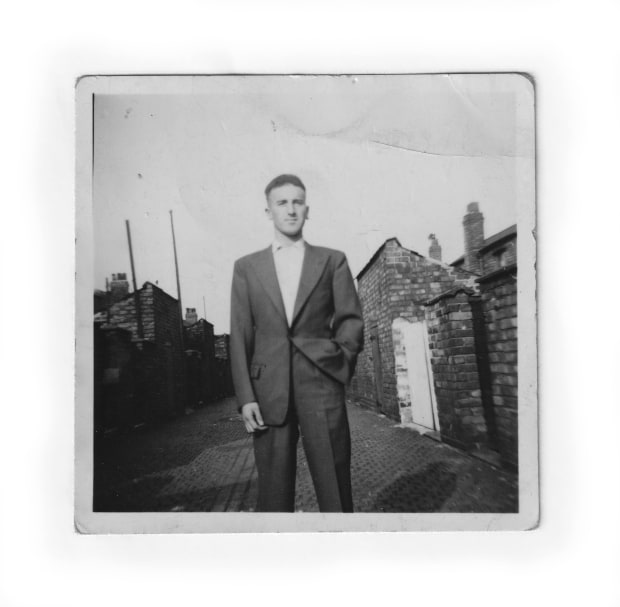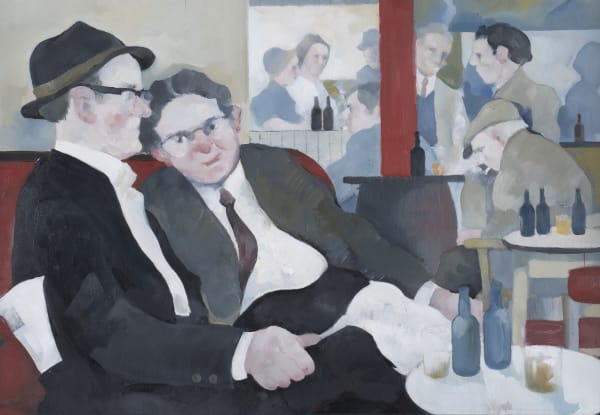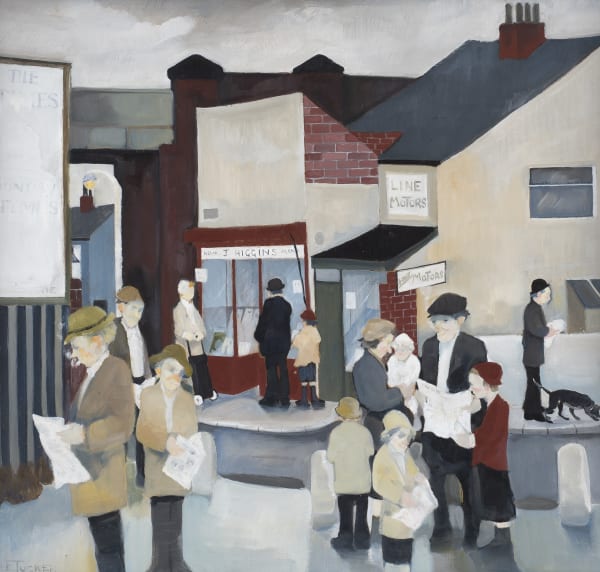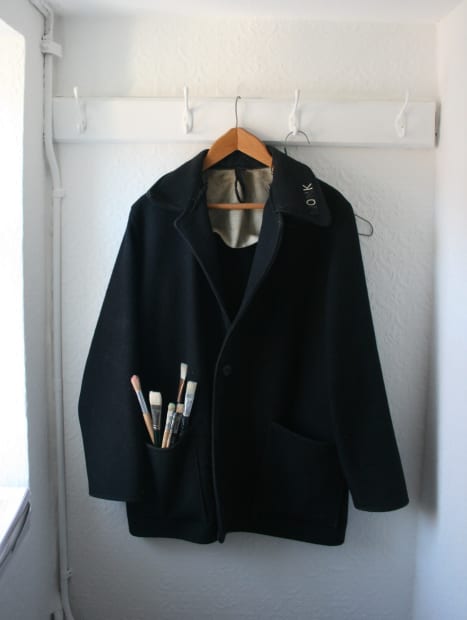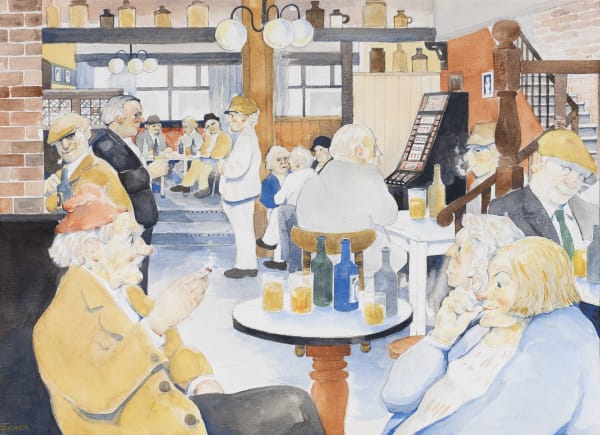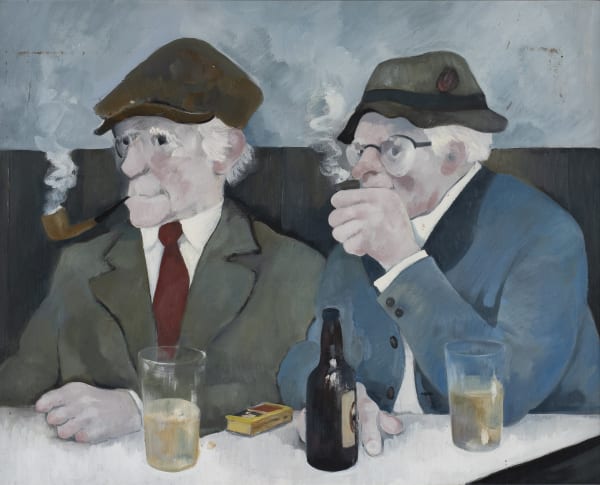-


-
FOLLOWING THE SELL OUT 2020 ONLINE EXHIBITION ERIC TUCKER: WATERCOLOURS CONNAUGHT BROWN AND ALON ZAKAIM FINE ART ARE DELIGHTED TO PRESENT AN EXHIBITION OF FORTY OIL PAINTINGS AND WATERCOLOURS BY ERIC TUCKER
-

-
-
-
-
 Eric TuckerWhite Hair and MoustacheOil on board16 x 23 in, 40.6 x 58.4 cmSigned 'ETucker' mid/lower leftSold
Eric TuckerWhite Hair and MoustacheOil on board16 x 23 in, 40.6 x 58.4 cmSigned 'ETucker' mid/lower leftSold
On view at Connaught Brown -
 Eric TuckerTop Hatted DuoOil on canvas15 x 15 in, 38.1 x 38.1 cmSigned 'ETucker' lower leftSold
Eric TuckerTop Hatted DuoOil on canvas15 x 15 in, 38.1 x 38.1 cmSigned 'ETucker' lower leftSold
On view at Alon Zakaim Fine Art -
 Eric TuckerThe Concert RoomOil on canvas17 x 24 in, 43.2 x 61 cmSigned 'ETucker' lower leftSold
Eric TuckerThe Concert RoomOil on canvas17 x 24 in, 43.2 x 61 cmSigned 'ETucker' lower leftSold
On view at Connaught Brown -
 Eric TuckerCity Bar Manchester (II)Watercolour on paper10 x 14 in, 25.4 x 35.6 cmSigned 'ETucker' lower left
Eric TuckerCity Bar Manchester (II)Watercolour on paper10 x 14 in, 25.4 x 35.6 cmSigned 'ETucker' lower left
On view at Alon Zakaim Fine Art
-
 Eric TuckerHouse No. 9Oil on board17 x 21 in, 43.2 x 53.3 cmSigned 'ETucker' lower rightSold
Eric TuckerHouse No. 9Oil on board17 x 21 in, 43.2 x 53.3 cmSigned 'ETucker' lower rightSold
On view at Alon Zakaim Fine Art -
 Eric TuckerCiggie in Hand Talks to Flat CapOil on canvas14 1/8 x 18 in, 35.9 x 45.7 cmSigned 'ETucker' lower leftSold
Eric TuckerCiggie in Hand Talks to Flat CapOil on canvas14 1/8 x 18 in, 35.9 x 45.7 cmSigned 'ETucker' lower leftSold
On view at Alon Zakaim Fine Art -
 Eric TuckerBarnum MontageWatercolour on paper16 x 20 in, 40.6 x 50.8 cmOn view at Alon Zakaim Fine ArtSold
Eric TuckerBarnum MontageWatercolour on paper16 x 20 in, 40.6 x 50.8 cmOn view at Alon Zakaim Fine ArtSold -
 Eric TuckerPricing Up at the ScrapyardOil on board17 x 21 in, 43.2 x 53.3 cmSigned 'ETucker' lower leftSold
Eric TuckerPricing Up at the ScrapyardOil on board17 x 21 in, 43.2 x 53.3 cmSigned 'ETucker' lower leftSold
On view at Connaught Brown
-
 Eric TuckerMysteryOil on canvas18 x 24 in, 45.7 x 61 cmSold
Eric TuckerMysteryOil on canvas18 x 24 in, 45.7 x 61 cmSold
On view at Connaught Brown -
 Eric TuckerThree Hoops and a FirebreatherOil on board19 x 24 in, 48.3 x 61 cmSigned 'ETucker'Sold
Eric TuckerThree Hoops and a FirebreatherOil on board19 x 24 in, 48.3 x 61 cmSigned 'ETucker'Sold
On view at Connaught Brown -
 Eric TuckerSpotOil on board24 x 25 in, 61 x 63.5 cmSigned 'ETucker' lower leftSold
Eric TuckerSpotOil on board24 x 25 in, 61 x 63.5 cmSigned 'ETucker' lower leftSold
On view at Connaught Brown -
 Eric TuckerBar Scene with Piano and DrumsOil on board19 x 27 in, 48.3 x 68.6 cmSigned 'ETucker' lower leftSold
Eric TuckerBar Scene with Piano and DrumsOil on board19 x 27 in, 48.3 x 68.6 cmSigned 'ETucker' lower leftSold
On view at Alon Zakaim Fine Art
-
 Eric TuckerPlay 'Temptation' For MeOil on board19 1/4 x 27 3/4 in, 49 x 70.5 cmSigned 'ETucker' lower rightSold
Eric TuckerPlay 'Temptation' For MeOil on board19 1/4 x 27 3/4 in, 49 x 70.5 cmSigned 'ETucker' lower rightSold
On view at Connaught Brown -
 Eric TuckerThe Cyclist, c.1960-70Oil on board17 1/2 x 17 3/8 in, 44.4 x 44 cmSigned 'Eric' lower rightSold
Eric TuckerThe Cyclist, c.1960-70Oil on board17 1/2 x 17 3/8 in, 44.4 x 44 cmSigned 'Eric' lower rightSold
On view at Alon Zakaim Fine Art -
 Eric TuckerTwo Gents - Confidential ChatOil on board12 1/2 x 18 in, 31.8 x 45.7 cmOn view at Alon Zakaim Fine ArtSold
Eric TuckerTwo Gents - Confidential ChatOil on board12 1/2 x 18 in, 31.8 x 45.7 cmOn view at Alon Zakaim Fine ArtSold -
 Eric TuckerStrange TheatreOil on board23 x 35 in, 58.4 x 88.9 cmSigned 'ETucker' lower leftSold
Eric TuckerStrange TheatreOil on board23 x 35 in, 58.4 x 88.9 cmSigned 'ETucker' lower leftSold
On view at Alon Zakaim Fine Art
-
 Eric TuckerConspiratorsOil on board12 x 16 in, 30.5 x 40.6 cmSigned 'ETucker' lower leftSold
Eric TuckerConspiratorsOil on board12 x 16 in, 30.5 x 40.6 cmSigned 'ETucker' lower leftSold
On view at Connaught Brown -
 Eric TuckerMarket StallsWatercolour on paper11 x 16 in, 27.9 x 40.6 cmOn view at Alon Zakaim Fine ArtSold
Eric TuckerMarket StallsWatercolour on paper11 x 16 in, 27.9 x 40.6 cmOn view at Alon Zakaim Fine ArtSold -
 Eric TuckerView of Town ClockOil on board18 3/8 x 21 3/4 in, 46.8 x 55.4 cmOn view at Alon Zakaim Fine ArtSold
Eric TuckerView of Town ClockOil on board18 3/8 x 21 3/4 in, 46.8 x 55.4 cmOn view at Alon Zakaim Fine ArtSold -
 Eric TuckerThe Reading PublicOil on board18 x 19 1/8 in, 45.7 x 48.5 cmSigned 'ETucker' lower leftSold
Eric TuckerThe Reading PublicOil on board18 x 19 1/8 in, 45.7 x 48.5 cmSigned 'ETucker' lower leftSold
On view at Connaught Brown
-
-

-
-
 Eric TuckerBar Scene with Tucker Painting on WallOil on board15 1/8 x 22 1/8 in, 38.2 x 56.2 cmSigned 'ETucker' lower rightSold
Eric TuckerBar Scene with Tucker Painting on WallOil on board15 1/8 x 22 1/8 in, 38.2 x 56.2 cmSigned 'ETucker' lower rightSold
On view at AZFA -
 Eric TuckerBonfire NightOil on board20 x 27 in, 50.8 x 68.6 cmSold
Eric TuckerBonfire NightOil on board20 x 27 in, 50.8 x 68.6 cmSold
On view at Alon Zakaim Fine Art -
 Eric TuckerHappy HourWatercolour on paper14 x 19 in, 35.6 x 48.3 cmSigned 'ETucker' lower leftSold
Eric TuckerHappy HourWatercolour on paper14 x 19 in, 35.6 x 48.3 cmSigned 'ETucker' lower leftSold
On view at Connaught Brown -
 Eric TuckerGuaranteed Used CarsOil on board16 x 21 in, 40.6 x 53.3 cmOn view at Connaught BrownSold
Eric TuckerGuaranteed Used CarsOil on board16 x 21 in, 40.6 x 53.3 cmOn view at Connaught BrownSold
-
 Eric TuckerCard PlayersOil on board22 x 26 in, 55.9 x 66 cmOn view at Connaught BrownSold
Eric TuckerCard PlayersOil on board22 x 26 in, 55.9 x 66 cmOn view at Connaught BrownSold -
 Eric TuckerFactory on the Doorstep (version 2), 1986Oil on board11 x 15 in, 27.9 x 38.1 cmSigned 'ETucker' lower rightSold
Eric TuckerFactory on the Doorstep (version 2), 1986Oil on board11 x 15 in, 27.9 x 38.1 cmSigned 'ETucker' lower rightSold
On view at Connaught Brown -
 Eric TuckerShe's Giving Him The EyeWatercolour on paper8 x 12 in, 20.3 x 30.5 cmSigned 'ETucker' lower leftSold
Eric TuckerShe's Giving Him The EyeWatercolour on paper8 x 12 in, 20.3 x 30.5 cmSigned 'ETucker' lower leftSold
On view at Alon Zakaim Fine Art -
 Eric TuckerPipe SmokersOil on board18 x 22 in, 45.7 x 55.9 cmOn view at Alon Zakaim Fine ArtSold
Eric TuckerPipe SmokersOil on board18 x 22 in, 45.7 x 55.9 cmOn view at Alon Zakaim Fine ArtSold
-
 Eric TuckerBalls in the AirOil on board21 x 28 in, 53.3 x 71.1 cmSigned 'ETucker' lower leftSold
Eric TuckerBalls in the AirOil on board21 x 28 in, 53.3 x 71.1 cmSigned 'ETucker' lower leftSold
On view at Connaught Brown -
 Eric TuckerCircus Scene with Plate Spinner and RingmasterWatercolour on paper14 x 20 in, 35.6 x 50.8 cmSigned 'ETucker' lower rightSold
Eric TuckerCircus Scene with Plate Spinner and RingmasterWatercolour on paper14 x 20 in, 35.6 x 50.8 cmSigned 'ETucker' lower rightSold
On view at Connaught Brown -
 Eric TuckerRed Ear with GlassesOil on board16 x 20 in, 40.6 x 50.8 cmOn view at Connaught BrownSold
Eric TuckerRed Ear with GlassesOil on board16 x 20 in, 40.6 x 50.8 cmOn view at Connaught BrownSold -
 Eric TuckerSunday Night, SmithfieldOil on board16 x 19 in, 40.6 x 48.3 cmSigned 'ETucker' lower leftSold
Eric TuckerSunday Night, SmithfieldOil on board16 x 19 in, 40.6 x 48.3 cmSigned 'ETucker' lower leftSold
On view at Alon Zakaim Fine Art
-
 Eric TuckerStreet Scene with VanOil on board16 x 20 in, 40.6 x 50.8 cmSigned 'ETucker' lower leftSold
Eric TuckerStreet Scene with VanOil on board16 x 20 in, 40.6 x 50.8 cmSigned 'ETucker' lower leftSold
On view at Connaught Brown -
 Eric TuckerStreet Scene in RedsWatercolour on paper4 x 6 in, 10.2 x 15.2 cmSold
Eric TuckerStreet Scene in RedsWatercolour on paper4 x 6 in, 10.2 x 15.2 cmSold
On view at Connaught Brown -
 Eric TuckerHouse No. 9Watercolour on paper10 x 14 in, 25.4 x 35.6 cmSigned 'ETucker' lower leftSold
Eric TuckerHouse No. 9Watercolour on paper10 x 14 in, 25.4 x 35.6 cmSigned 'ETucker' lower leftSold
On view at Alon Zakaim Fine Art -
 Eric TuckerThe Concert RoomWatercolour on paper11 1/4 x 15 in, 28.5 x 38 cmOn view at Connaught BrownSold
Eric TuckerThe Concert RoomWatercolour on paper11 1/4 x 15 in, 28.5 x 38 cmOn view at Connaught BrownSold
-
 Eric TuckerThe CafeOil on board10 x 11 in, 25.4 x 27.9 cmSigned 'ETucker' lower leftSold
Eric TuckerThe CafeOil on board10 x 11 in, 25.4 x 27.9 cmSigned 'ETucker' lower leftSold
On view at Alon Zakaim Fine Art -
 Eric TuckerThe PierWatercolour on paper13 x 19 in, 33 x 48.3 cmSigned 'ETucker' lower rightSold
Eric TuckerThe PierWatercolour on paper13 x 19 in, 33 x 48.3 cmSigned 'ETucker' lower rightSold
On view at Connaught Brown -
 Eric TuckerDog WalkersOil on board15 1/4 x 23 1/2 in, 38.9 x 59.7 cmSigned 'ETucker' lower leftSold
Eric TuckerDog WalkersOil on board15 1/4 x 23 1/2 in, 38.9 x 59.7 cmSigned 'ETucker' lower leftSold
On view at Alon Zakaim Fine Art
-
-
-
Q&A with the Artist’s Brother, Tony Tucker
Since his death in 2018, Eric Tucker has gained national, and even international, acclaim for depicting the dramas of everyday life in Warrington. But during his lifetime, self-taught artist Eric Tucker was secretive about his talent, keeping it private from all but close family. Just who was the man behind these masterpieces?
Art historian Ruth Millington spoke to the artist’s younger brother, Tony Tucker, to find out more about this ‘Secret Lowry’.
You’re the one who discovered Eric’s work – stacks and stacks of it – in his house. Were you surprised?
Yes! People might be surprised that I was surprised, since I visited him regularly, but I only saw parts of the house. I knew he painted in the front room and that there were some paintings upstairs, but I had no real sense of how much material there really was. In the last year of his life – when Eric mentioned that it would be good if he could have a show at the local gallery – I looked upstairs in the bedrooms, which were piled high with art around the walls and even on the beds. Later on I realised there were paintings in the loft, under the stairs and even in the shed at the back of the house. The whole business was pretty startling.
Do you remember Eric being interested in art when he was a boy?
Eric was ten years older than me, so I was quite young when I became conscious of his presence in my life, and he was important to me as there was only my mother, brother and myself. He must have been in his teens and yes, I remember he was always interested in drawing: he had a little box of watercolours, pencil and paper. The first artworks he did, which I was aware of, were at my grandmother’s little terraced house. During the war we were put in a cupboard under her stairs whenever the air raid sirens went off and he covered those walls with drawings. Then, during his mid-teens, he joined a boxing club and at that point you can see he begins to draw lots and lots of fine, detailed portraits of famous fighters.
Eric left school at 14. What was his working life like? Was it completely separate from his art?
Eric’s interest in art got him an apprenticeship as a sign writer, but he packed it in. He was an independent character and didn’t like being told what to do, so he did what any other person who leaves school at 14 with no professional skills does: he worked as a labourer on building sites, jobs that would last sometimes for months, sometimes for a few weeks or just days. At one point he worked as a grave digger and at another in a brewery. That was his life, working as an unskilled labourer, and he got on with it. It was a risky kind of life working in the building trade – he got injuries or work could suddenly finish and you could find yourself on the dole. Good friends would depend on each other: Eric once gave his weekly wage to a friend who was out of work, saying “you need this more than me”.
I gained the sense from some of his old friends, including another boxer, that he was reticent about saying anything about his painting.
In the retrospective at Warrington Museum in 2019 there was a brilliant recreation of the front room Eric used as a studio. It was filled with art books, so it’s obvious that he had an interest in art history. Were you aware of this?
We did go to exhibitions together and, in later years, I was his chauffeur. He liked the Pre-Raphaelites – we went quite a few times to the Lever Gallery – as well as showing interest in painters such as Van Gogh and Gauguin. His favourite Pre-Raphaelite painting, as a labourer himself of course, was Work by Ford Madox Brown. He bought the Sunday Times, for the colour supplement, in which you could see something about art and I think he really appreciated that.
He discovered Edward Burra, who made a huge impression on him. We visited London on occasions, often for a Rugby League cup final, and would also head to the galleries. I remember we saw an Edward Burra show at Tate. The last show I ever took him to was at Nottingham University because they were showing Burra’s work.
As a self-taught, working-class artist, how do you think Eric felt about the established art world?
He dismissed most art movements from the ‘60s onwards - abstract expressionism, pop art etc, and was solely interested in figurative art. As a working[1]class man it also took a lot of courage for Eric to actually walk into a private gallery, look around and engage with someone, but he did this in Manchester, and even in London, as well as visiting the public galleries. He always felt completely outside of it though. He was an individual who had little education, and no art education, so it was a world that was very disconnected to him.
Didn’t Eric once meet Lowry in a gallery in Manchester?
He did! It was only the two of them in the gallery at the time and they struck up conversation. It was Lowry who made some comment to him about a work, and they had a chat. Lowry suddenly turned to him and said, “I’ve never worked, you know”. Eric replied, “You’ve done your work, Mr. Lowry”. Of course Lowry meant he had never done a working job; he kept the fact that he had been a rent collector under his hat for quite a while.
Many comparisons have been drawn with Lowry – do you think Eric would have liked these?
Eric admired Lowry and he was an inspiration, there is no doubt about that, but there is also a real difference in the way they approached their art. Although Eric was working on the same streetscapes and painting working-class life, he’s radically different from Lowry. Lowry is the outsider looking in and my brother is the insider looking out. My brother is one of the people in the pictures, he knows them all
Eric was a sociable man then… He was immensely sociable. He was hesitant about meeting people he regarded as middle class, and it took a lot to persuade him to come on a cruise in later life as he felt this was something only rich or ‘posh’ people did. But once we got him on, and at the dinner table, he was the life and soul of the party. He was a very witty man. I never thought about this, as we grew up together, but he was a very intelligent person. He was funny and sharp and loved comedy. He was a comedian himself: once he got on a riff, at the pub, he was terrifically inventive, a real wit. He was eccentric, complex – maddeningly at times – but generous and warm-hearted.
Eric’s paintings have such a great affect on people. When you hosted a small exhibition in his home, hundreds of visitors lined up around the block. What do you think draws so many people to your brother’s work?
Oh yes, the house show. That was amazing. We – his family – wanted at the very least for him to be recognised as an artist, even if it was only his neighbours and the local community who saw his work. We set the house up as a gallery and we were going to open the doors to the public at 10am, but by 9am people were already waiting outside the house. In the event over two days 2000 people queued to see it and they loved it. They so wanted to see his work. There was a lady in tears who said “this is the world I knew.” For working-class older people somebody had represented them, he had shown their world in a way that they thought had perhaps been ignored or forgotten.
Eric’s world is definitely not being ignored now. What would your brother have made of this exhibition and his success?
There’s no doubt he liked London and visited many times. So the fact that he’s in two Mayfair galleries would have astonished him – but I’m sure he would have enjoyed it and loved the idea that the shows are happening. If only he were around to have savoured the moment, a recognition at last of who he truly was – an artist.
-
